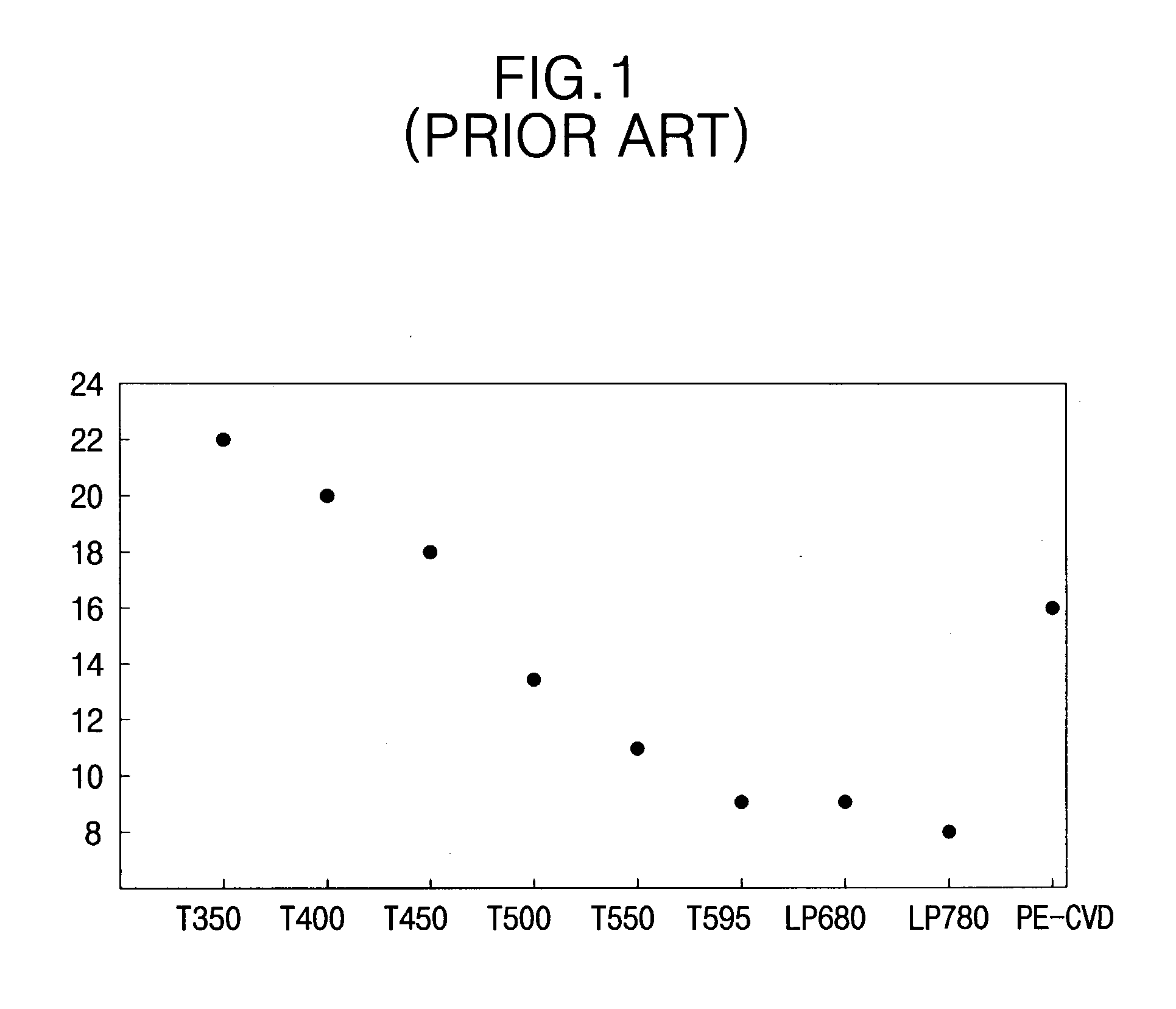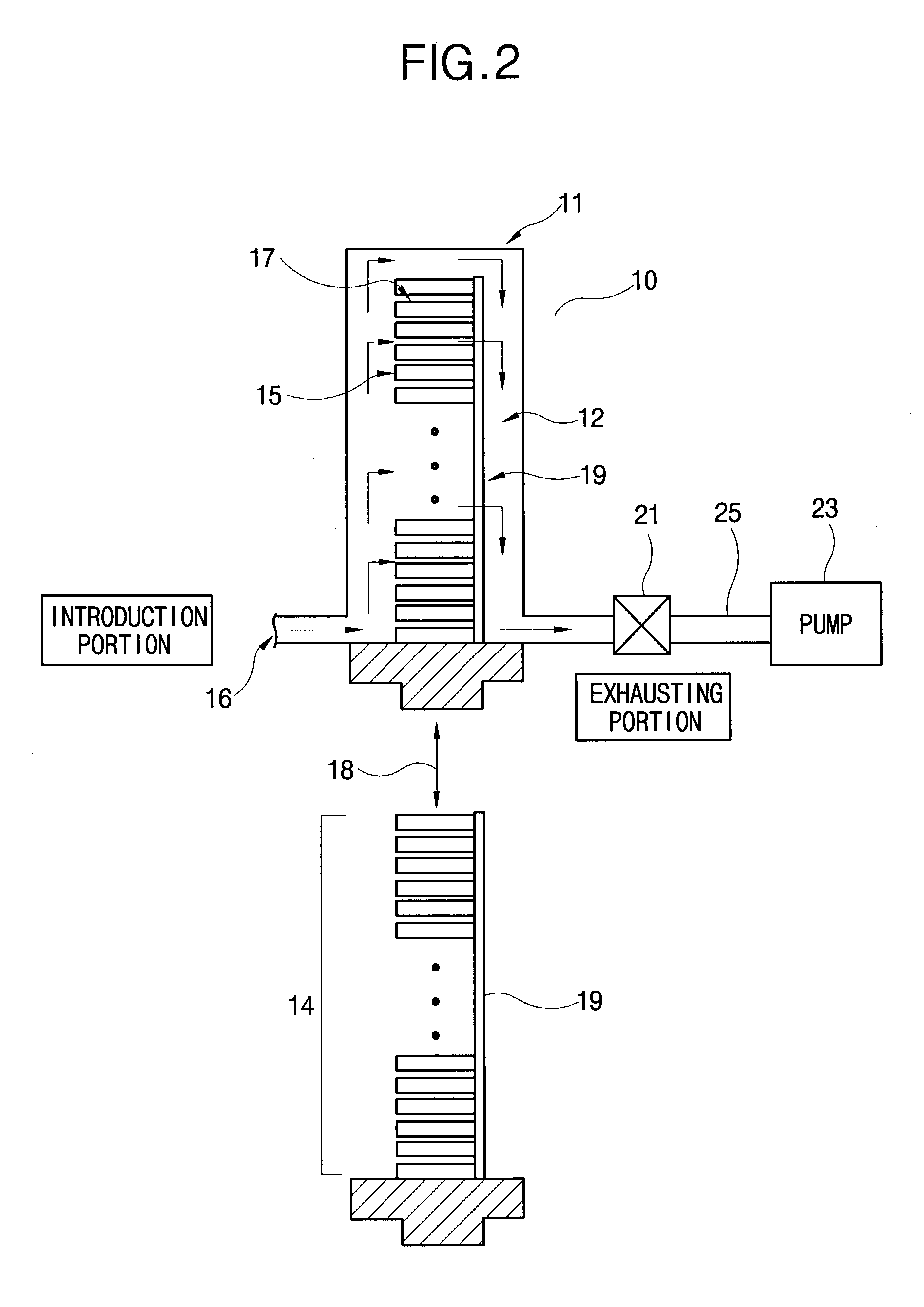Method of forming a thin film with a low hydrogen content on a semiconductor device
a technology of semiconductor devices and thin films, which is applied in the direction of coatings, chemical vapor deposition coatings, metallic material coating processes, etc., can solve the problems of high hydrogen content severely affecting the performance of semiconductor devices, and poor step coverage of lpcvd thin films
- Summary
- Abstract
- Description
- Claims
- Application Information
AI Technical Summary
Problems solved by technology
Method used
Image
Examples
embodiment 1
[0048] Embodiment 1
[0049] FIG. 4 is a flow chart explaining a method of forming a thin film according to a first embodiment of the present invention. Referring to FIG. 4, a method of forming a thin film according to the present embodiment is described as follows. Silicon nitride (SiN) is deposited using a ALD process, as described above, at a temperature of about 550.degree. C. The DCS gas and the ammonia (NH.sub.3) gas are used as the first and the second reacting materials, respectively. A flow rate of the ammonia (NH.sub.3) gas to the DCS gas is about 4.5:1. The ammonia (NH.sub.3) gas is provided by a remote plasma generator.
[0050] First, a silicon substrate is loaded into the chamber (step 100). A DCS dosing step is carried out for about 20 seconds so as to introduce the first reacting materials (step 105), and then the chamber is pumped out for about 10 seconds so that the internal pressure of the chamber is in a vacuum state. Next, the nitrogen (N.sub.2) gas, activated by the ...
embodiment 2
[0053] Embodiment 2
[0054] FIG. 5 is a flow chart explaining a method of forming a thin film according to a second embodiment of the present invention. Referring to FIG. 5, the method of forming a thin film according to the present embodiment is described as follows.
[0055] A silicon nitride (SiN) is deposited using an ALD process, as described above, at a temperature of about 550.degree. C. The DCS gas and the ammonia (NH.sub.3) gas are used as the first and the second reacting materials, respectively. A flow rate of the ammonia (NH.sub.3) gas to the DCS gas is about 4.5:1. The ammonia (NH.sub.3) gas is provided from remote plasma generator.
[0056] First, a silicon substrate is loaded into the chamber (step 200). A DCS dosing step is carried out for about 20 seconds to supply the first reacting materials in to the chamber (step 205), and then the non-chemisorbed DCS are purged from the chamber by supplying an inert gas, e.g., a nitrogen (N.sub.2) gas, into the chamber for about 3 seco...
embodiment 3
[0058] Embodiment 3
[0059] FIG. 6 is a flow chart for explaining a method of forming a thin film according to a third embodiment of the present invention.
[0060] According to this embodiment, a silicon nitride (SiN) is deposited using an ALD process, as described above, at a temperature of about 550.degree. C. The DCS gas and the ammonia (NH.sub.3) gas are used as the first and the second reacting materials, respectively. A flow rate of the ammonia (NH.sub.3) gas to the DCS gas is about 4.5:1. The ammonia (NH.sub.3) gas is provided by a remote plasma generator.
[0061] First, a silicon substrate is loaded into the chamber (step 300). A DCS dosing step is carried out for about 20 seconds to supply the first reacting materials into the chamber (step 305), and then the non-chemisorbed DCS is purged from the chamber by supplying an inert gas, e.g., as a nitrogen (N.sub.2) gas, into the chamber for about 3 seconds (step 310). After the chamber is purged of non-chemisorbed DCS, the chamber is...
PUM
| Property | Measurement | Unit |
|---|---|---|
| Concentration | aaaaa | aaaaa |
| Content | aaaaa | aaaaa |
Abstract
Description
Claims
Application Information
 Login to View More
Login to View More - R&D
- Intellectual Property
- Life Sciences
- Materials
- Tech Scout
- Unparalleled Data Quality
- Higher Quality Content
- 60% Fewer Hallucinations
Browse by: Latest US Patents, China's latest patents, Technical Efficacy Thesaurus, Application Domain, Technology Topic, Popular Technical Reports.
© 2025 PatSnap. All rights reserved.Legal|Privacy policy|Modern Slavery Act Transparency Statement|Sitemap|About US| Contact US: help@patsnap.com



